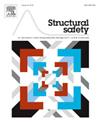Seismic fragility analysis of building clusters considering the effects of mainshock-aftershock sequences
IF 6.3
1区 工程技术
Q1 ENGINEERING, CIVIL
引用次数: 0
Abstract
The impact of the mainshock earthquake on the regional building cluster is significant, directly causing varying degrees of damage to many houses. A large amount of onsite seismic loss observation data indicate that aftershocks after the main earthquake also impact the damage to and vulnerability of regional buildings. To study the seismic fragility and risk of typical building clusters under mainshock-aftershock sequences, this paper innovatively proposes a structural seismic fragility model that considers the intensity measures of the mainshock-aftershock by combining total probability and Bayesian theory. A computational intensity model has been developed that considers the directionality of ground motion under mainshock-aftershock sequences. The established model was verified and analyzed on the basis of 384,882 accelerations monitored by nine strong motion stations during the Jiuzhaigou earthquake on August 8, 2017, in China. The calculated intensity point cloud and stripe models were generated on the basis of the directional effect of ground motion. Using the Chinese earthquake intensity scale and the proposed computational intensity model, the fragility of three types of building clusters (1212 buildings) affected by the Jiuzhaigou earthquake was estimated, and a structural failure probability model considering mainshock-aftershock sequences was established. A seismic fragility curve of a building cluster considering the influence of mainshock-aftershock sequences was plotted via the Gaussian process, least squares regression algorithm, and data-driven techniques. An innovative structural fragility correlation surface was generated to analyze the correlation characteristics between different fragility levels under the influence of mainshock-aftershock sequences. The traditional earthquake damage index method has been improved, and a structural fragility index function considering the impact of mainshock-aftershocks has been proposed.
考虑主余震序列影响的建筑群地震易损性分析
主震地震对区域建筑群的影响较大,直接对许多房屋造成不同程度的破坏。大量的现场地震损失观测数据表明,主震后的余震也会对区域建筑物的损坏和易损性产生影响。为了研究主余震序列下典型建筑群的地震易损性和危险性,本文创新性地将总概率理论与贝叶斯理论相结合,提出了考虑主余震烈度测度的结构地震易损性模型。建立了考虑主余震序列下地震动方向性的计算强度模型。基于2017年8月8日九寨沟地震期间9个强震台站监测到的384882个加速度,对所建立的模型进行了验证和分析。基于地震动的定向效应,生成了计算强度点云和条纹模型。利用中国地震烈度标度和提出的计算烈度模型,对九寨沟地震影响的3类建筑群(1212栋建筑)的易损性进行了估算,建立了考虑主余震序列的结构破坏概率模型。利用高斯过程、最小二乘回归算法和数据驱动技术,绘制了考虑主余震序列影响的建筑物群地震易损性曲线。构造了一个创新的结构易损性相关面,分析了主余震序列影响下不同易损性水平之间的相关特征。对传统的震害指数方法进行了改进,提出了考虑主震-余震影响的结构易损性指数函数。
本文章由计算机程序翻译,如有差异,请以英文原文为准。
求助全文
约1分钟内获得全文
求助全文
来源期刊

Structural Safety
工程技术-工程:土木
CiteScore
11.30
自引率
8.60%
发文量
67
审稿时长
53 days
期刊介绍:
Structural Safety is an international journal devoted to integrated risk assessment for a wide range of constructed facilities such as buildings, bridges, earth structures, offshore facilities, dams, lifelines and nuclear structural systems. Its purpose is to foster communication about risk and reliability among technical disciplines involved in design and construction, and to enhance the use of risk management in the constructed environment
 求助内容:
求助内容: 应助结果提醒方式:
应助结果提醒方式:


